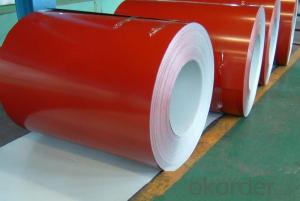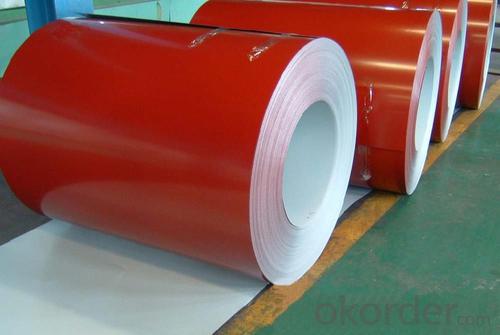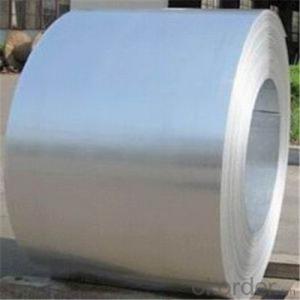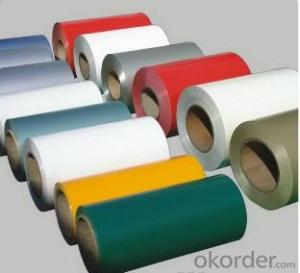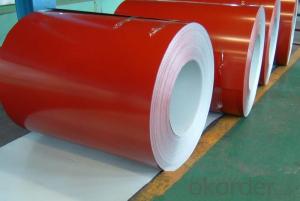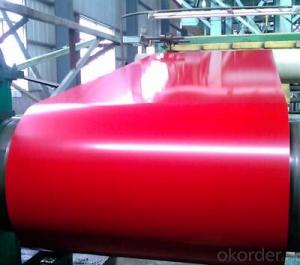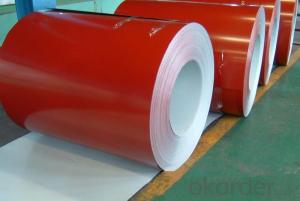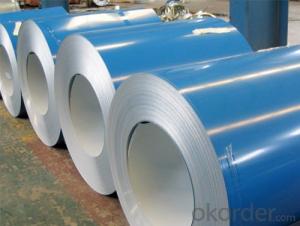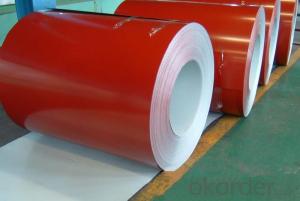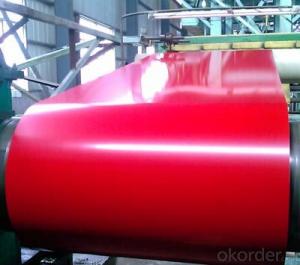Pre-painted Galvanized/Aluzinc Steel Sheet Coil with Prime Quality and Lowest Price in Red
- Loading Port:
- Shanghai
- Payment Terms:
- TT OR LC
- Min Order Qty:
- 100 m.t.
- Supply Capability:
- 10000 m.t./month
OKorder Service Pledge
OKorder Financial Service
You Might Also Like
1.Pre-Painted Galvanized/Aluzinc Steel Coil Description:
Pre-painted Galvanized Steel Coil chemical treatment and liquid dope with several layers of color
2.Main Features of the Pre-Painted Galvanized/Aluzinc Steel Coil
• Good capable of decoration
• Superior strength
• High workability
• Good visual effect
3.Detail Images of Pre-Painted Galvanized Steel Coil
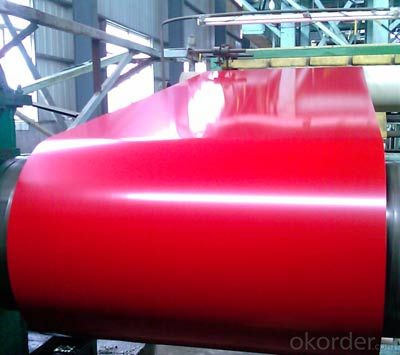
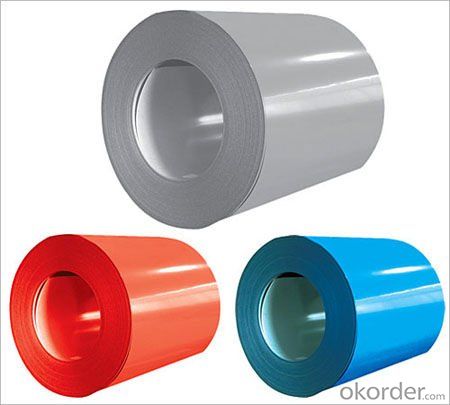
1) AVAILABLE DESIGNATION OF PPGI/PPGL Prepainted Galvanized/Galvalume Steel Coils
Quality | Q/BQB 440-2003 | JIS G3312-1994 | EN 10326-2004 | ASTM A653-02a |
EN 10327-2004 | (BASE PLATE) | |||
(BASE PLATE) | ||||
Commercial Steel | TDC51D | CGCC | DX51D+Z/AZ | CS Type A/B/C |
Forming Steel | (TSt01,TSt02,TSt03) | CGCD1 | FS Type A, Type B | |
Drawing | TDC52D /TDC53D | - | DX52D+Z/AZ | DDS TYPE A/C |
Steel | DX53D+Z/AZ | |||
Structural | TS280GD(TStE28) | CGC400 | S280D+Z/AZ | SS275 |
Available Painting OF PPGI/PPGL (Prepainted Galvanized/GalvalumeSteel Coils) :
Category of Painting | Item | Code | |
Polyester | PE | ||
High-durability polyester | HDP | ||
Silicon modified polyesters | SMP | ||
Polyvinylidene fluoride | PVDF | ||
Easy-Cleaning | — | ||
Painting Thickness | Top side: 5+20microns; | ||
Bottom side: 5~7microns. | |||
Color System | Produce according to RAL Color System or as per buyer’s color sample. | ||
Painting structure | Top surface | Bottom surface | |
Primer coating | No coating | 1/0 | |
Primer coating | Primer coating | 1/1 | |
Primer coating + Finish coating | No coating | 2/0 | |
Primer coating + Finish coating | Primer coating or single back coating | 2/1 | |
Primer coating + Finish coating | Primer coating + Finish back coating | 2/2 | |
Note: Protect film available
5.FAQ
2. What’s the brand of the paint?
We use the best brand of all of the word—AKZO.
- Q: How are steel coils used in the manufacturing of automotive hoods?
- Steel coils are used in the manufacturing of automotive hoods as they are shaped and cut into specific dimensions to create the hood's structure. These coils are typically formed into panels through processes like stamping, pressing, and forming, which are necessary to achieve the desired shape and strength.
- Q: What is the yield strength of steel coils?
- The yield strength of steel coils can vary depending on the specific grade and composition of the steel. However, the typical yield strength of steel coils ranges from 300 to 600 megapascals (MPa).
- Q: How are steel coils used in the manufacturing of metalworking tools?
- Steel coils are a crucial component in the manufacturing of metalworking tools. These coils, which are typically made from high-quality steel, are used in various stages of the production process to create different types of metalworking tools. One of the primary uses of steel coils in the manufacturing of metalworking tools is for the production of blades and cutting tools. The coils are typically cut into specific lengths and then shaped and sharpened to create the blades that are used for cutting, shaping, and milling various metals. The high-quality steel used in these coils ensures that the resulting blades are durable, strong, and capable of withstanding the demanding conditions of metalworking processes. Steel coils are also used in the manufacturing of drill bits and other types of metalworking tooling. The coils are shaped and machined to create the desired size and shape of the tool, and then hardened and tempered to increase their strength and durability. This ensures that the resulting tools can withstand the high-speed drilling and cutting operations involved in metalworking. Furthermore, steel coils are used to create the bodies and handles of metalworking tools. The coils are typically formed into the desired shape and size using various forming techniques such as bending, rolling, and stamping. These formed pieces are then welded or fastened together to create the final structure of the tool. The high-quality steel used in the coils ensures that the resulting tool bodies and handles are strong, rigid, and capable of withstanding the forces and vibrations associated with metalworking operations. In summary, steel coils play a vital role in the manufacturing of metalworking tools. They are used to create blades, drill bits, bodies, and handles, providing the necessary strength, durability, and precision that are required in metalworking processes. These coils are an essential raw material that enables the production of high-quality, reliable, and efficient metalworking tools.
- Q: How are steel coils protected from chemical damage?
- Steel coils are protected from chemical damage through various methods such as applying protective coatings, using corrosion inhibitors, and storing them in controlled environments to minimize exposure to harmful chemicals.
- Q: What are the different coil packaging options available for steel coils?
- There are several coil packaging options available for steel coils, including wooden crates, steel strapping, steel or plastic banding, shrink wrap, and stretch film. These packaging materials help protect the steel coils during transportation and storage, preventing damage from moisture, corrosion, and shifting.
- Q: which is the most tough and durable steel type ??
- Speaking of Building Construction, we use grade 450 and 450B not because of toughness, its because it best serves its purpose, reinforcing concrete structure should provide the enough ductility of structure to resist flexure/bending when loads are imposed on it.
- Q: What are the different methods of joining steel coils?
- There are several methods of joining steel coils, including welding, using mechanical fasteners, and adhesive bonding. Welding is a common technique that involves melting and fusing the edges of the coils together using heat. Mechanical fasteners, such as bolts or screws, can also be used to secure the coils together. Additionally, adhesive bonding involves using a strong adhesive to bond the coils together. Each method has its own advantages and considerations depending on the specific application and requirements.
- Q: We have a stain from a pot or bowl in our new expensive stainless steel sink. It looks like a water mark that happens when you leave a glass on a table without a coaster. It's a mark in the shape of the bowl or pot that was there. We left it there overnight:( It's not rust either. Help!
- The best product I have ever come across is Barkeeper's Friend. I use the liquid version rather than powdered version. It is a soft soft abrasive scrub designed for stainless steel. I original found it to use it on all my All Clad pots and pans to keep them beautiful and shining. I also have a stainless kitchen now, sink, stove and fridge...and I use Barkeepers on everything. It is fantastic. If you don't want to go out and find Barkeepers tonight, you can get a similar affect using baking soda mixed with dish soap. Make a good paste to gently rub on stains. Be sure to rinse the stainless steel surface thoroughly, and towel dry. If the stains still remain you can try vinegar. Remember to thoroughly rinse and towel dry. But tomorrow go out and get a bottle of BarKeeper's Friend...you will never regret it. UPDATE: just saw a few other answers, DO Not use steel wool (SOS pads) you will scratch the heck out of the finish and you will not be able to fix it.
- Q: If rebar steel is welded together as opposed to 'tied' does it decrease the strength of the steel?
- If done correctly it should increase the tensile strength at least.
- Q: ...particularly for jewelry?
- Surgical stainless steel is a variation of steel usually consisting of an alloy of chromium (12–20%), molybdenum (0.2–3%), and sometimes nickel (8–12%). The chromium gives the metal its scratch-resistance and corrosion resistance. The nickel provides a smooth and polished finish. The molybdenum gives greater hardness, and helps maintaining a cutting edge. In metallurgy, stainless steel (inox) is defined as a ferrous alloy with a minimum of 10% chromium content.[1] The name originates from the fact that stainless steel does not stain, corrode or rust as easily as ordinary steel. This material is also called corrosion resistant steel when it is not detailed exactly to its alloy type and grade, particularly in the aviation industry
Send your message to us
Pre-painted Galvanized/Aluzinc Steel Sheet Coil with Prime Quality and Lowest Price in Red
- Loading Port:
- Shanghai
- Payment Terms:
- TT OR LC
- Min Order Qty:
- 100 m.t.
- Supply Capability:
- 10000 m.t./month
OKorder Service Pledge
OKorder Financial Service
Similar products
Hot products
Hot Searches
Related keywords
